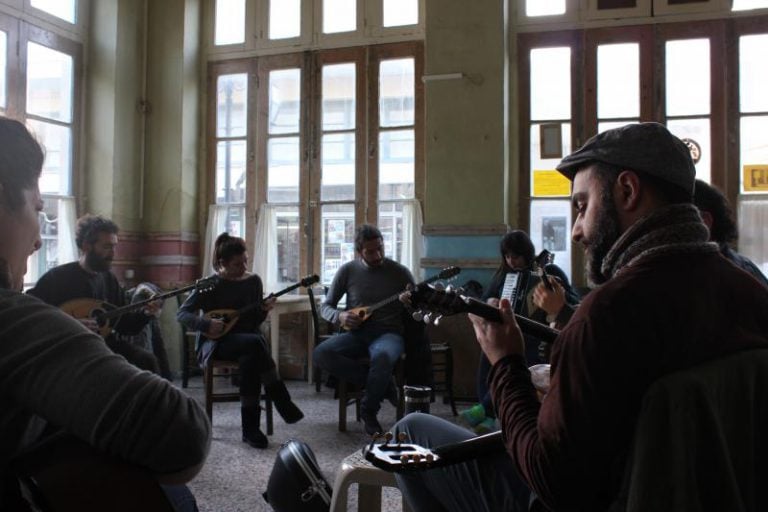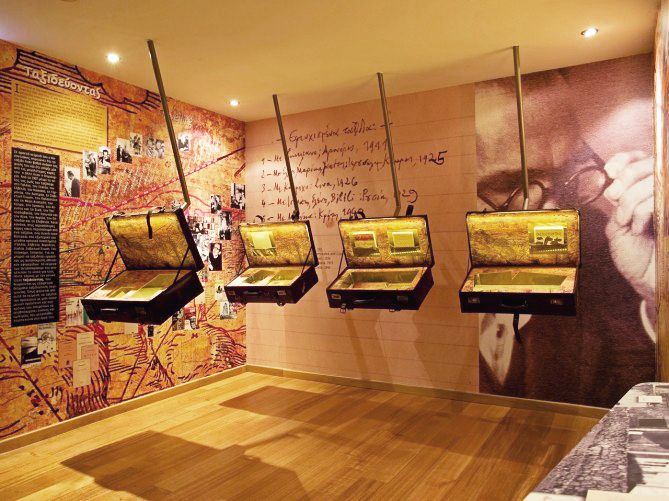About three and a half million overseas visitors will arrive in Crete through Heraklion’s Nikos Kazantzakis Airport in 2017; hundreds of thousands more will arrive by cruise ship. Most will head to resort hotels and the tourist hotspots, but for those who want to take a quieter road, to feel what Kazantzakis, Greece’s foremost modern writer, described as Crete’s “mysterious force enabling the soul to grow” – one of the most fruitful paths to take is the road to Archanes, 15 kilometres south of Heraklion.
For an outsider to begin to understand a Cretan community, its history and culture, there’s no better place to start than the local kafenion. At the Kafenion I Plateia overlooking the main square in Archanes, some 40 elderly men are seated at a dozen tables, sharing stories, reading newspapers, playing tavoli and sipping their ellinikos kafes. Most are retired farmers. The large high-ceilinged cafe, with its tall neoclassical windows is from another age; stepping inside is a portal to the past.
I sit with 82-year-old Dimitrios Mikonyakis, who was a carpenter in his younger days. Dimitrios has been coming here since he was a child. His father was a barrelmaker, servicing the local wine makers; he came here too, almost every day of his life.
“It was the first kafenion in the town,” says Dimitrios.
“It’s always been important to the farmers. The cultivation of sultana raisins and grapes for wine provided the old men around us a livelihood.
“Raisins were something unique in those days. They made the town wealthy, not now,” he adds ruefully.
“It was a rich town back then. The landowners and some families had big houses but the farmers didn’t own their land. Today it’s fairer.”

The fight for justice, and resistance to Crete’s invaders through the centuries, is very much part of Archanes’ story. A vital revolutionary centre during the 1897 Cretan revolt against the Ottomans, from here the local Defence Committee co-ordinated military actions against Turkish forces throughout eastern Crete – battles that greatly influenced Crete’s move to becoming an independent state in 1898, and unification with Greece a decade later.
In WWII, after its role as the headquarters for the Greek army units who fought in the Battle of Crete, Archanes became the main German command centre during the Occupation. Though Dimitrios was only a child during the war, like all those of his generation, his memories of the Nazi occupation are vivid.
“There were two types of German soldier here,” he says. “The Germans soldiers were brutal, but the Austrian ones were kinder.”
An early centre for espionage activity during the Occupation, it was near Archanes that one incident, on 26 April 1944, ensured the region’s fame in WWII folklore: the abduction by British agents and andartes of the German general Heinrich Kreipe. Kreipe had his office in Archanes, and the spot where the abduction took place on the road to Knossos, three kilometres north of Archanes, is marked by a memorial at the roundabout near Patsides.

Neoclassicism
With 200 heritage-listed buildings, Archanes is a treasure trove of elegant neoclassical architecture. First adopted in Crete in large public buildings built in Ottoman times, well-to-do Archanians, wanting to express their love for, and desire to unite with Greece, built their residences in the neoclassical style – a style spurred on by the founding of the Greek state in 1832. Neoclassicism revolutionised interior layouts, replaced old materials with new, and was influenced by German classicism and romanticist movements, and a wish to revive the elegance of Ancient Greece.

Living history
Tucked away in its own peaceful walled garden above the main square, Kalimera Archanes Village comprises three rustic villas that date from the early 19th century. Lovingly renovated by owner Anna Petromichelaki, each is furnished in traditional style, offering guests a delightful insight into village life from a bygone age – with added luxury comforts. Ever helpful hotel manager Lefteris Chatzipapas is on hand to offer his deep knowledge of the town and region, and Lefteris’ advice presents a unique chance to gain an intimate experience of the history and culture of the area. He can even organise a day of grapepicking with the locals if you want to turn your stay into a working holiday!

Each morning a breakfast of delicious home-made delicacies is brought to your villa to set you up for the day; whether its a climb of Mount Giouchtas, a trip to Knossos, or a visit to one of the nearby wineries. Kalimera Archanes Village was one of the first properties invited to become a member of the Yades Greek Historic Hotels Group, whose mission is to celebrate Greece’s cultural heritage by uniting hotels of exceptional historical significance. Like the other 18 properties in the Yades Collection across the Greek mainland and islands Kalimera’s ethos is about giving its guests exceptional accommodation and a deep insight into the traditions and culture of the local community. Characteristic of Archanes, says Lefteris, is the community’s natural generosity.
“It’s the people that make this place different,” he says.
“It’s the life we have here, the hospitality you’ll meet. If you pass by a house and smell something nice cooking, they’ll say ‘come in, join us, taste it!'”
Open all year round, the cosy two-storey villas at Kalimera Archanes Village offer one, two and three-bedroom options, all with living rooms and well-equipped kitchens. Ideal for couples, families and group bookings, if you’re looking for a place to blend seamlessly with the community that surrounds you, Kalimera makes an ideal base.

Restaurant pick – Kritamo
Dimitris Mavrakis offers some of the best food in town at this taverna just off the main square. Offering fresh, local ingredients, (try the succulent local lamb pedakia), the internationally-trained Dimitris has carved out a well-deserved repuation for fine Cretan cuisine.
Around Archanes
Knossos
The big one. A 10-kilometre drive takes you to Crete’s most famous historical attraction. If you want to beat the crowds (and the heat), plan to arrive before 10.00 am and allow a few hours to explore this iconic Bronze Age site, the ceremonial and political centre of the legendary Minoan civilisation. Guided tours (which give much needed interpretation) leave from near the ticket booth. Tip: Bring a picnic or take a late lunch in the nearby wine country; the onsite touristy tavernas at Knossos are mediocre.
Museum of Nikos Kazantzakis
Writer, philosopher, politician and traveller, Nikos Kazantzakis (1883-1957) was born in Heraklion. In the village of Mytria (six kilometres from Archanes), this creatively imagined museum pays tribute to an icon of modern Greek literature. With its collection of his manuscripts, samples of his correspondence, personal effects and rare photographs, the museum has become a site of worldwide pilgrimage.

Houdetsi
Nine kilometres south of Archanes, Houdetsi is home to the fascinating Labyrinth Musical Workshop established by world-famous longtime-Cretan resident lyra player Ross Daly. Daly’s Musical Workshop has become a globally recognised educational centre for traditional Cretan folk music and other world music forms and is a museum for the collection, preservation and promotion of traditional musical instruments from around the world.
Also at Houdetsi, Rhous Winery is the 50-hectare estate of the Tamiolakis family. Producing 50,000 bottles a year of some of the finest organic wine in Crete, the grapes are nurtured in the local calcium-rich clay soil. Grape varieties used include the traditional red varieties of the Peza region – Kotsifali and Mandilari. Whites from the Vilana grape, the most popular in the region, also feature. The winery is open year-round for tastings and sales.
Mount Giouchtas
Fancy a stiff mountain walk before lunch? Five kilometres west of the town, Mount Giouchtas (summit 811m), has spectacular views and a wealth of historic sites. On its north side are the remains of one of the most important Minoan peak sanctuaries, built around 2100 BC and believed to be the summer palace of Knossos. According to mythology Zeus was buried here.
Getting there
Aegean Airlines operates four services daily to Heraklion from Athens.
Michael Sweet was a guest of Kalimera Village Archanes and travelled to Heraklion from Athens with the assistance of Aegean Airlines.
